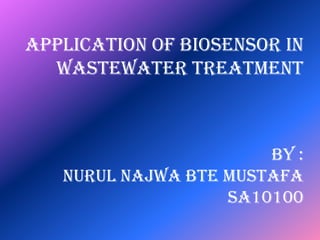Application of biosensor in wastewater treatment
- 1. Application of Biosensor in wastewater treatment By : NURUL NAJWA BTE MUSTAFA SA10100
- 2. Biosensor o Defined as sensors that allow the measurement and interpretation of the biological response of activated sludge to a known disturbance. o Which converts a biological response into an electrical signal o Detects, records and transmit
- 3. • To obtain specific information about one or several activated sludge processes. • This information can serve as plant performance indicators. • Most often in the form of a substrate addition : Purpose i. organic carbon, ii. nitrogen, iii.mixtures,
- 4. Working principle a – Bio-element b – Transducer c – Amplifier d – Processor e – Display
- 5. Application • The application of biosensor in wastewater treatment described about removal of COD and N removal processes • Divided into two direction : i. On-line sensors - To obtain information about wastewater treatment plant ii. More advanced dynamic models
- 6. Respirometer
- 8. Advantages • Small volume • Ease from construction • Ability to be used at low pO2 values • The ability to rapidly change the composition of the buffer in which tissue slices are suspended.
- 9. Conclusions • Full understanding of the complicated biological interactions in a wastewater treatment plant is essential to optimize treatment plant operation, aiming at reaching a good effluent quality against minimum

